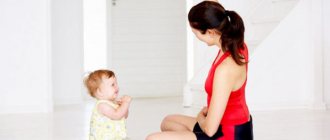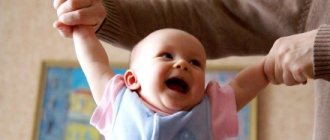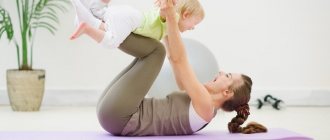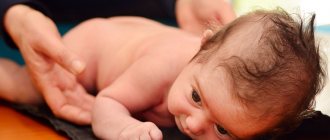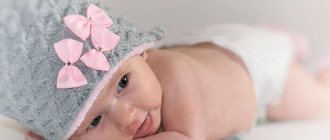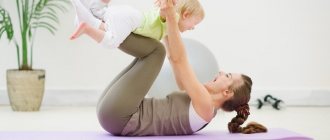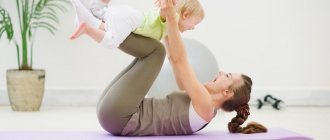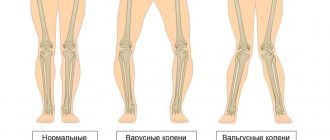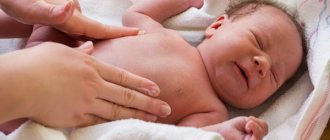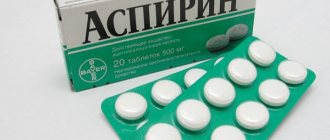For newborns
For newborn children, a characteristic feature is muscle hypertonicity, which manifests itself in the form of tightly closed fists and bent arms and legs. The baby needs to be helped to relieve tension and the best assistant in this case is a relaxing massage.
When performing a massage on a newborn, you need to consider that:
- Before performing the procedure, you need to thoroughly wash your hands and then warm them;
- Before starting the manipulations, you need to talk to the baby gently and calm him down with your voice;
- All movements should be neat and smooth, it is advisable to smile at the baby;
- The massage consists of stroking;
- Do not massage areas of the spine, lymph nodes, heart, knees and armpits;
- Apply massage creams, fragrances and additives;
- It is recommended to perform a relaxing massage before bedtime, so the baby will wake up much less often;
- The duration of the first session should be no more than 5 minutes, gradually, the time can be increased to 20 minutes;
- The baby's crying indicates discomfort, so you need to postpone the procedure.
In addition, you can use the following massage complex:
- The baby is placed on his back, after which you need to stroke his arms from the hands to the shoulders, and perform circular rubbing.
- You need to place a finger in the palm of the baby and use it to stroke from the center to the periphery.
- The area from the child's ankle to the thigh is treated with kneading movements, and then circular scrolling is done.
- It is necessary to tap the baby's legs with the pads of your fingers.
- The baby is placed on his stomach. From the shoulder area to the lower back and from the tailbone to the sides, stroke.
Therapeutic massage and gymnastics
Therapeutic massage is prescribed only by a pediatrician and only after undergoing a specialized specialist (neurologist, orthopedist, surgeon, cardiologist, etc.). For many medical problems, a well-conducted course of massage gives an excellent effect as part of a comprehensive treatment.
Indications for therapeutic massage in children from one year to fourteen are myalgia, neuralgia, osteochondrosis, headaches, arthritis, radiculitis, cerebral palsy, paralysis, flat feet, spinal curvature, pleurisy, bronchitis, stomach or duodenal ulcers, chronic gastritis, chronic heart failure, recovery period after a fracture or injury. For different diseases, there are different therapeutic massage protocols that are most effective for solving a specific problem.
For babies from 1 year
A daily relaxing massage will help your baby get rid of problems related to poor sleep. The baby’s well-being improves and his emotional mood rises.
Classic relaxing massage for children includes the following exercises:
- It is necessary to place the child on his back. We stroke the face, you need to move from the forehead to the lips. The earlobes must be massaged.
- The child's chest is stroked, after which his arms are spread in different directions and crossed on his chest.
- Circular stroking movements of the abdomen are performed, they are performed clockwise. Both legs of the child are taken into the hands, after which they need to be straightened, and then bent at the knees, slightly pressing on the abdominal area.
- You need to place your fingers on your hand like a rake, and then use them to perform light stroking movements on the child’s back. You need to go from the buttocks to the shoulders, and then in the opposite direction.
- The shoulders are massaged with palms and fingers, after which you need to gradually lower yourself to the hands.
- It is necessary to carefully (without applying pressure) massage the areas located on both sides of the spine. Initially, movements are performed from the bottom up, and then in the opposite direction.
- Shaking is performed, an open palm is applied to the baby's skin. Initially, the shoulders are developed, and then the arms and back.
- Using your fingertips, you need to tap along the entire back, avoiding direct impact on the child’s spine.
- The feet are rubbed, after which, using fan-shaped movements of the fingers, the area from the ankle to the buttock should be stroked. Shaking movements are performed. Similar manipulations are repeated with the second leg.
The duration of the procedure for babies over one year old is from 20 to 30 minutes.
https://youtu.be/kIHZY3MzjIk
Gymnastics for a 1 year old child
Before starting classes with your child, the room must be ventilated for 15 minutes. Gymnastics and massage begin either an hour and a half after a meal, or before a meal, but no less than 30 minutes.
It is advisable to do gymnastics in the morning. You can involve other children and all family members in activities with your baby. Gymnastics should take place in a playful way, and should begin and end with the child’s favorite exercises. Each exercise should be repeated 5-7 times, new ones - 2-3 times. During gymnastics, you need to work out all muscle groups. The set of classes includes the same exercises as a month earlier. You can add walking on a narrow path, to prevent flat feet - on a ribbed surface, raising straight legs from a lying position to a right angle, raising the body from a lying position, alternately raising arms, throwing a ball with both hands, walking behind a gurney, getting objects from a height, lifting head and body parts lying on the back, arching the body, crawling under objects, somersaults. Regular walks, swimming, and, if possible, a swimming pool, hardening, and air baths should also be included in the complex of health-improving activities.
Legs
A relaxing foot massage for a child is performed according to the following plan:
- In your left hand you need to take the baby's ankle joint and place it between the index and middle fingers.
- In parallel with this, stroking movements are performed from the baby’s foot with the right hand. With their help, you need to engage the area up to the shin, after which the lateral and then the front part of the thigh is warmed up. The actions are repeated for several minutes, after which you need to move on to the groin area.
- After performing light stroking, you need to return to treating the thigh and lower leg.
- Next, the baby’s foot is rubbed, on which an infinity sign is then drawn with the fingers.
- The foot is warmed up by light pressure from the thumb.
https://youtu.be/SauKhuiJaT8
After performing the presented manipulations, you need to grab the baby’s leg with your right hand and fix his knee with your left. After this, flexion and extension of the legs are carried out for the proper functioning of the hip and knee joints.
Children's foot and back massage
Massage of the legs and back should be given special attention if the child is involved in sports and dancing. The fact is that child athletes often have back and leg pain due to the fact that the muscles become clogged with lactic acid, and this can even provoke injury. Therefore, massage is a must for young athletes, but, unfortunately, it is often forgotten.
Sports massage allows you to keep muscles elastic and functional, relieve pain, fatigue and heaviness in the legs, and relax after training. It makes dancing and sports much safer, allowing the child to regain strength and be in excellent psychophysiological shape for each next lesson.
Back and buttocks
A relaxing massage of the back and buttocks is done before bed. The procedure includes performing the following manipulations:
- The child is placed on his stomach;
- Using your fingertips, gently and with light movements, warm up the skin on your back;
- Stroking is carried out in the direction from the neck to the lower back;
- Using light circular movements, warms up in the buttocks area.
Perform all manipulations carefully, so as not to cause pain in the child.
Massage techniques for a one-year-old child
From 1 year of age, baby massage can be performed in any position, starting with large areas of the body, usually the back. If the baby does not want to lie down during stimulation, you can massage him while sitting or even standing. All massage techniques are used - stroking, rubbing, sawing, pinching, kneading, vibration (the latter, however, must be done very carefully). Stroking prepares the child’s body for the massage, and also serves as its completion, activates blood circulation, relaxes muscles, has a calming effect, and relieves pain. Rubbing improves blood flow and tissue nutrition, has a beneficial effect on the skin, subcutaneous tissues, tendons, muscles and ligaments. Kneading, which affects deeper located muscles, has a similar effect; also, during kneading, lymph circulation is activated and the respiratory system is strengthened. Vibration has a beneficial effect on the nervous system, has an analgesic effect and improves metabolism.
Thoracic zone
Also, to relax the muscles of young children, massage in the chest area is considered quite relevant. The procedure includes the following actions:
- The child turns over on his back, after which circular strokes are carried out clockwise;
- Using light and rubbing movements, you need to treat the area from the baby’s chest to the armpits;
- Gentle finger tapping is performed on the child's ribs.
It should be remembered that the external muscles of a baby under one year old are quite weak, so when performing a relaxing massage it is imperative to combine pressure and vibration.
General restorative (preventive) massage and gymnastics
General strengthening massage is useful for children with weak immunity, children in the rehabilitation period after illness or injury, those who are often ill, leading a sedentary lifestyle, having problems with sleep and appetite, as well as children with increased workload in kindergarten and school.
This massage strengthens the musculoskeletal system, stimulates the child’s physical development, helps improve posture and improve immunity. A restorative massage copes well with the problems of hyperexcitability and chronic fatigue, and increases the child’s mental and physical performance.
Every mother of a small child knows about the benefits of restorative massage for the baby’s health. Pediatricians and neurologists often recommend taking massage courses at certain stages of growing up. On the Internet you can find a huge number of specialists specializing in baby massage, but mothers need to know that in some cases they can massage their baby at home on their own.
Of course, such a statement may cause some fear in mothers, because this is not taught in preparation courses for motherhood. But even a person who does not have a medical education is quite capable of mastering this art, the main thing is to understand how to properly massage a child.
In this article we will talk about the benefits of baby massage, what types of massage a mother can do at home on her own, and how to properly massage a child. And also, in what cases is it better to use the services of a specialist, and how to choose a specialist that suits you.
So, what are the benefits of baby massage:
- Relaxes muscles.
- Improves blood circulation.
- Strengthens the immune system.
- Helps in the development of the musculoskeletal system.
- Relieves nervous tension.
- Has a calming effect on colic.
- Helps with the functioning of the gastrointestinal tract.
- Used in combination to harden a child.
- Provides tactile contact between mother and child.
- Helps in the treatment and prevention of congenital malformations.
But in order for a massage to really bring benefits and in no way cause harm, you need to understand how to properly massage a child.
There are several types of baby massage that a mother can perform on her own:
- A restorative massage combined with gymnastics for babies in their first year of life.
- Massage to help relieve pain from baby colic.
- Drainage massage for children who have suffered from bronchitis.
- Massage the nasolacrimal duct if signs of conjunctivitis or congenital blockage appear.
How to properly give a restorative massage to a child?
This procedure must be carried out daily, for 5-6 minutes. When massaging, you can use light stroking movements, applying gentle pressure on the baby's tiny body. Before the massage procedure, the baby must be undressed, first making sure that the room temperature is comfortable.
Next, you need to powder your hands with hypoallergenic baby powder, and then begin to lightly rub the baby’s hands in the direction from the hand to the shoulder. First, go over the outside of the arm, then the inside. After rubbing, start massaging the hands: open and stroke the baby’s palms, then lightly massage the fingers.
Next, you can massage your baby's tummy with circular movements clockwise. Then start massaging your legs: with light rubbing movements, walk along the outside of your leg, in the direction from the foot to the thigh.
There is no need to massage the inner thigh, as this area has a large accumulation of lymph nodes, and unprofessional massage can be harmful. After massaging your legs, start massaging your feet. Using gentle pressure, draw figure eights on your foot and rub your index finger from heel to toe. Gently massage each finger.
Turn the baby onto his tummy. Using light pressure movements from bottom to top, massage first the calves, then the back of the thigh. Massage your buttocks with your thumbs, rubbing from bottom to top, and with stroking movements, finish the procedure with a back massage along the spine. There is no need to massage the spine itself; inept movements can cause harm. At the end of the massage, lightly stroke the baby with light soothing movements and dress him.
As a rule, restorative massage is used in combination with gymnastics, the exercises of which are aimed at helping the baby master the skills of turning over, crawling, sitting and walking. There is a separate set of exercises for each skill, the selection of which is best left to a professional.
The most important rule when conducting a restorative massage is that the process should bring pleasure to both mother and child. If the baby cries or protests, stop the procedure.
In addition, you should not perform a massage if the child is sick, overtired or overexcited, or if the sleep-wake pattern is disrupted during the day. A hungry child will most likely not like the massage either, but it will also bring little pleasure immediately after eating.
A restorative massage is a strong load on the child’s body, so it must be carried out during active wakefulness.
How to properly do a massage to help relieve pain from colic? Make sure the room temperature is comfortable and undress your baby. Place your hand on the tummy so that the heel of your right palm rests on the baby's pubic bone and your fingers on the tummy. Using light stroking movements, begin the massage in a clockwise direction. Massage as needed until relief occurs.
How to properly give drainage massage to a child who has had bronchitis
This type of massage helps children expel mucus accumulated in the bronchi during illness. The drainage massage procedure can be carried out after consultation with a pediatrician, making sure that the baby will not be harmed. During one procedure, you can carry out the described set of actions 3-4 times.
- Place your baby's upper body in your lap, face down.
- Ensure that the baby's pelvis is slightly elevated above the head.
- Using pressing movements with the fingers of both hands, massage the area under the shoulder blades towards the head. Continue the massage for 5-7 minutes.
- Have your baby sit down and ask him to cough for as long as necessary.
How to properly massage the nasolacrimal duct for a child?
This type of massage is required for children in the first months of life who were born with blockage of the nasolacrimal duct. Due to the blockage, the tear fluid does not enter the nasopharynx and provokes “souring” of the eye. As a rule, this pathology goes away on its own; if this process is delayed, the pediatrician may prescribe the mother to perform a massage procedure.
Place the pad of your index finger just above the lacrimal sac, which is located in the inner corner of the eye.
Carry out a massage using a pressing movement of the fingertip, reminiscent of a comma, on the point of the lacrimal canal from top to bottom.
You should not perform a massage without consulting a specialist. And during your consultation, it is best to ask your pediatrician to demonstrate the correct technique.
There are other massage techniques that are used to correct various diseases and lagging children in physical development. These types of massages are strictly not recommended for parents to perform on their own, so as not to cause irreparable consequences for the child’s health.
Any corrective massages can be done by a person with a medical education and only after the appointment of the doctor treating the child. In addition to the diploma, the specialist must have a certificate confirming his qualifications.
The qualifications of a children's massage therapist are confirmed every 5 years, so pay attention to the date the document was received.
The certificate must also indicate the type of massage that the massage therapist has. Make sure that the specialist you choose has the equipment that is right for you. If you plan to do a massage outside the walls of a medical institution, ask the specialist to provide a health book.
It is best to ask your pediatrician or neurologist for contact details of a trusted massage therapist. You can also use forums for young mothers, and after collecting a sufficient number of reviews, decide on your choice. When you first meet, pay attention to the child’s reaction; if the baby shows distrust or protest, it is better to look for another massage therapist.
Read more information about caring for babies and helping them with sleep-related problems on Tatyana Kremneva’s blog.
Author: Tatyana Kremneva.
What you need to know to massage children at home
The first massage sessions are recommended to be carried out under the supervision of a specialist who will show the correct massage technique to achieve maximum effect. The baby should be in a good mood, then the benefits of the massage will be more significant. You will not only strengthen your baby’s body, but also establish close contact with him by performing the procedure regularly. Massage children at home in the form of a game, smile more often yourself, encouraging the child to make visual contact, talk to him, tell rhymes and jokes, sing songs. Basic rules of massage:
- from the first weeks of life, the child can be given a massage, only lightly stroking;
- at the age of 1.5 -2 months, simple gymnastic exercises can be included in the complex. Regular training will give the best effect;
- experts do not recommend doing a tonic massage before bed;
- the temperature in the room where the massage session will be performed should not be higher than 23 degrees;
- remember that a baby’s skin is very delicate and reacts to foreign irritants, so you need to be extremely careful not to injure it;
- there is no need to massage the liver area, genitals; when massaging the back, kidneys, shock techniques (claps, tapping) should be avoided.
